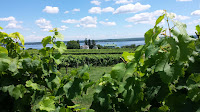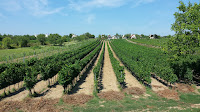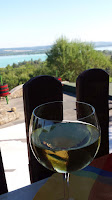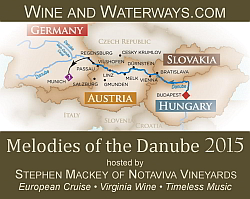 |
| Seneca Lake from Fox Run Vineyards |
I recently discovered that August is the optimal time to visit Balatonfüred Hungary as the village hosts "The Wine Weeks of Balatonfüred". This festival features wines and palinka (grape brandy) produced in the
Balatonfüred-Csopak wine region. This is a historical tourist destination located in the northeast corner of Lake Balaton. August is also an optimal time to visit New York's
Finger Lakes as I did as a participant in the 2015
Wine Bloggers Conference. Visiting both regions a week apart highlighted the numerous similarities in viticulture between the Finger Lakes and Lake Balaton and specifically between Seneca Lake and Balatonfüred-Csopak. These similarities include the climate, soil, and grapes.
 |
| Vineyard in Balatonfüred |
Grape growing in both wine regions benefit from lake induced micro-climates. Lake Balaton is the largest lake in Central Europe whereas Seneca Lake is the largest and deepest of the Finger Lakes. Both lakes moderate severe winter temperatures and in some areas, vineyards located a mile from each lake are protected. Seneca Lakes provides more of this thermal retention as the lake never freezes, whereas Lake Balaton sports a thin layer of ice in winter - as it is much shallower. In summer, the lakes lengthen the diurnal temperature by acting as a mirror during the daytime and elevating the temperature and then absorbing the excess heat at night - preserves the balance of natural acids in the grape.
At various times during our WBC15 visit we learned how diverse the soils can be around Seneca Lake. This was first revealed during the pre-excursion to
Fox Run Vineyards and enforced during a presentation at the conference. This slide to the left shows the diversity of soil types in just a small area on eastern Seneca Lake, plots of sand red clay, brown loam, shale, limestone, poor drainage and well drainage soils. And Fox Run has leveraged the different soil types into a Geology Series devoting two vineyards (Lake Dana Vineyard Block 11 and Hanging Delta Block 7) of Riesling in order to compare the interplay of terrior and wine making techniques. Soil diversity is also prevalent in Balatonfüred-Csopak as the soils is based upon volcanic shale, mingled with red sandstone, limestone, dolomite, and basalt. These conditions present a challenge for grape growers -- what to plant in each small plot.
 |
View of Lake Balaton
from Ferenc Csarda |
In some instances, the grapes planted in these soils are the same across both wine regions. An obvious similarity is Lemberger-Blaufrankish-Kékfrankos, the same grape known by different names. That the grape fares well in both regions wasn't surprising after I read
Finger Lakes Wine and the Legacy of Dr. Konstantin Frank (American Palate)
and
A Sense of Place: A Discovery of Finger Lakes Wine History, and Villa Bellangelo Winery
, ironically on the plane to Europe. Both books mention that the New York State Agricultural Experiment Station in Geneva had recommended planting vinifera grapes as far back as 1917, with one being the Hungarian variety Kadarka. This information was lost to the Finger Lakes until vinifera production was revived by Dr. Frank in the 1970s. Whereas Lemberger is a minor player in the Finger Lakes, it is the primary red grape in Balatonfüred-Csopak. Other red varieties such as Bordeaux grapes and Pinot Noir do have roles in both regions, although in Hungary only in the Tihany Peninsula just west of Balatonfüred.
 |
| Palinka & Swans |
As for white grapes there is a preponderance of cold climate Riesling varieties, just not the same Riesling variety. The signature grape for the Finger Lakes is Rhine Riesling whereas in the Balaton it is Olaszrizling (Welschriesling) - no relation between the two. In fact the origination of Welschriesling is still being debated - although it is extremely popular in central Europe - including Slovenia and Croatia. In both the Finger Lakes and Balatonfüred-Csopak, the Riesling grapes come in a range of styles from dry to semi-dry with plenty of acids to balance the sugar. Gewurztraminer (Tramini) is another common grape as well as Pinot Gris - although the Hungarian Szürkebarát version is more plentiful. Balatonfüred-Csopakis also home to several obscure indigenous grapes that I recommend sampling whenever possible: Juhfark (“Sheep’s Tail”), Leanyka (“Maiden”), Kiralyleanyka (“Princess”), and Zenit a rare modern day cross of the local Ezerjo variety, with the Slovenian Bouvier grape.Some of these are available at
Ferenc Csarda in Tihany and in Balatonfüred at the
Figula Borbár.
 |
| Wine Weeks in Balatonfüred |
The main difference between the two regions - particularly during the "Wine Weeks of Balatonfüred" - is the ease of consumption in the village. Kiosks were aligned along the main pedestrian path and revelers were able to walk along Lake Balaton sipping their wine. No open container or drinking in public laws in Hungary. Would be nice if this policy immigrated to the States. Regardless, cheers to both wine regions.




















